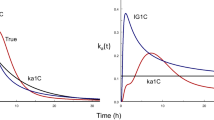Summary
Intrasubject variation in bioavailability (rate and extent) and disposition of furosemide 40 mg was investigated using a repeated, randomized, double-blind cross-over study in 8 healthy subjects. Two generic tablet formulations (Lasix and Furix) and intravenous furosemide were compared on 6 separate days. Extensive intrasubject variability after oral administration was observed in AUC, mean absorption time (MAT) and urinary excretion. The variability (error variance) within the dosage forms was as large as that between the two generics. These variations most probably depended on the absorption process, since the repeated i.v. doses showed only marginal intrasubject variability. Absolute bioavailability was 56% for Lasix and 55% for Furix (AUC). The range was 20 to 84% between individuals and the maximal range within one individual was 20 to 61%. Confidence interval and Bayesian analysis showed a high probability of non-equivalence not only between but also within the generics when the separate cross-over experiments were analyzed (8 observations). When extending the analysis to 16 observations, bioequivalence was demonstrated for the two generic tablets. Rate of absorption, quantified as MAT, was 128 min for Lasix and 98 min for Furix (16 observations). Since MAT was significantly longer (p<0.001) than the mean residence time after the i.v. dose (57 min), absorption was evidently the rate-limiting step in the overall kinetics of oral furosemide. Intraindividual variation in absorption is a confounding factor in bioavailability studies of furosemide using limited numbers of subjects. This is important to consider when designing and evaluating bioavailability studies for drugs showing these variations.
Similar content being viewed by others
References
Tyrer JH, Sutherland JM, Hooper WD (1970) Outbrake of anticonvulsant intoxication in an Australian city. Br Med J 4: 271–273
Linderbaum V, Mellow HM, Blackstone MD, Butter VP (1971) Variation in biological availability of digoxin from four preparations. N Engl J Med 285: 1344
Department of Health Education and Welfare, Food and Drug Administration (1977) Drug products. Bioequivalence requirements and in-vivo bioavailability procedures. Fed Reg, Part III 42: 1624–1653
National Board of Health and Welfare (Sweden). Appendix to the Code of Statutes (1980) Registration of pharmaceutical specialities. Instructions for submission of applications (SOSFS (M) 90: 49–56
Westlake WJ (1973) Dosage form and bioavailability. In: Swarbrick J (ed) Current concepts in the pharmaceutical science. Lea and Febiger, Philadelphia 149–179
Dagrosa EE, Hajdu P, Heptner W, Rupp W (1981) The role of intrasubject variations in bioavailability studies. Clin Pharmacol Ther 29: 239
Hammarlund MM, Paalzow LK, Odlind B (1984) Pharmacokinetics of furosemide in man after intravenous and oral administration. Application of moment analysis. Eur J Clin Pharmacol 26: 197–207
Cutler DJ (1978) Theory of the mean absorption time, an adjunct to conventional bioavailability studies. J Pharm Pharmacol 30: 476–478
Yamaoka K, Nakagawa T, Uno T (1978) Statistical moments in pharmacokinetics. J Pharmacokinet Biopharm 6: 547–558
Riegelman S, Collier P (1980) The application of statistical moment theory to the evaluation of in vivo dissolution time and absorption time. J Pharmacokinet Biopharm 8: 509–534
Westlake WJ (1976) Symmetrical confidence intervals for bioequivalence trials. Biometrics 32: 741–744
Spriet A, Beiler D (1978) Table to facilitate determination of symmetrical confidence intervals in bioavailability trials with Westlake's method. Eur J Drug Metab Pharmacokinet 2: 129–132
Rodda BE, Davis RL (1980) Determining the probability of an important difference in bioavailability. Clin Pharmacol Ther 28: 247–252
Benet LZ (1979) Pharmacokinetics/pharmacodynamics of furosemide in man: a review. J Pharmacokinet Biopharm 7: 1–27
Cutler RE, Blair AD (1979) Clinical pharmacokinetics of furosemide. Clin Pharmacokinet 4: 279–296
Smith DE, Lin ET, Benet LZ (1980) Absorption and disposition of furosemide in healthy volunteers measured with a metabolite-specific assay. Drug Metab Disp 8: 337–342
Waller ES, Hamilton SF, Massarella JW, Sharanevych MA, Smith RV, Yaktan GJ, Dolusio JT (1982) Disposition and absolute bioavailability of furosemide in healthy males. J Pharm Sci 71: 1105–1108
Brazzell RK, Kaplan SA (1983) Factors affecting the accuracy of estimated mean absorption times and mean dissolution times. J Pharm Sci 72: 713–715
Prasad VK, Rapaka RS, Knight PW, Cabana BE (1982) Dissolution medium — a critical parameter to identify bioavailability problems of furosemide tablets. Int J Pharm 11: 81–90
Nimmo WS (1976) Drugs, disease and altered gastric emptying. Clin Pharmacokinet 1: 189–203
Heck H d'A, Butrill SE, Flynn NW, Dryer RL, Anbar M, Carins T, Dighe S, Cabana BE (1979) Bioavailability of imipramine tablets relative to a stable isotope-labelled internal standard: increasing the power of bioavailability tests. J Pharmacokinet Biopharm 7: 233–248
Jack DB, Wilkins MR, Kendall, Hall PE (1983) Variability of plasma drug concentrations: some boservations. Eur J Clin Pharmacol 25: 569–570
Author information
Authors and Affiliations
Rights and permissions
About this article
Cite this article
Grahnén, A., Hammarlund, M. & Lundqvist, T. Implications of intraindividual variability in bioavailability studies of furosemide. Eur J Clin Pharmacol 27, 595–602 (1984). https://doi.org/10.1007/BF00556898
Received:
Accepted:
Issue Date:
DOI: https://doi.org/10.1007/BF00556898




